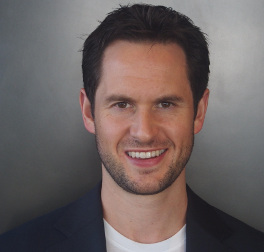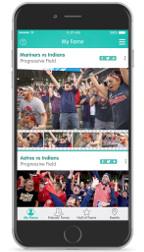15 Seconds Of Fame Seeks to Monetize Fan Video
NEW YORK—The late American artist Andy Warhol is famous for popularizing the notion of flash-in-the-pan notoriety.
“In the future, everyone will be world-famous for 15 minutes,” he said during a 1968 exhibit of his work in Sweden.
Well, if you can’t get 15 minutes, would you settle for 15 seconds? Manhattan-based 15 Seconds of Fame is hoping the answer is yes.
Since late 2015, the company has offered sports teams and leagues a way to build an even deeper connection with fans and generate new revenue by distributing video clips of fans broadcast during games and projected on venue video screens to the smartphones of the fan in the clip—thus giving individual fans a personalized keepsake of the game and their 15 seconds of fame.
The company has inked deals with various professional and college teams and leagues and today announced its latest agreement, a multi-year partnership with the National Hockey League.

In this interview, company CEO Brett Joshpe discusses the facial recognition software and other technologies that power the clips, the business model 15SOF hopes to cash in on, how the service is meeting the needs of advertisers questioning the ROI of venue advertising and how consumers can get their personalized clip.
TV TECHNOLOGY: From a workflow and technology point of view, tell me about the process.
BRETT JOSPHE: We do have access to a lot of content and ingest a lot of content. Really, it’s our technology that’s able to sort through that content and deliver it in an efficient manner.
Get the TV Tech Newsletter
The professional video industry's #1 source for news, trends and product and tech information. Sign up below.
There are a lot of things that go into our technology stack. Part of it is facial recognition. That’s only a part, but it’s kind of the backbone of what we do.
When we go into a venue we typically have some hardware. Not a lot, but some hardware.
We ingest feeds—whether it’s a video board feed, in the case of a league the TV feeds. We ingest that content and then use our software technology to process it.
TVT:What’s the turnaround time to make clips available to consumers?
BJ: It depends on bandwidth. It can be minutes. For instance, our contract for NHL content and MLB content requires us to wait till the end of the game. There are some contractual and practical considerations.
But from a technology standpoint, it literally can be minutes.
TVT:Do you use the cloud to run your facial recognition, editing and other software involved in the process?
BJ:A lot of our architecture is cloud-based. Some of it is local hardware. When we have to deal with a venue or team for their video board, we do have hardware on premise.
But a lot of the processing can be done in the cloud, and obviously we can spin up machines as we need them.
So it is a combination of both.
TVT:What’s involved on the consumer side of the equation?
BJ:A consumer downloads the app and takes a selfie. Then our technology is able to recognize them when they are on camera, cut out that clip and send it directly to their phone.
One of the really nice things about the product is that if you are at a game and you are on camera and you didn’t have the app beforehand, you can download it after the fact and go back and check and still get that content.
TVT:Is there a time limit on retrieving that content if a consumer downloads the app after the game?

BJ:Once we have the content we are able to deliver it. If we have access to the content we can deliver it so fans can go back pretty far in time.
TVT:You aren’t always going to get video of a fan with the shot square on the face. It might be in profile for instance. Can your facial recognition algorithm handle that?
BJ:Obviously, this is an area of technology that continues to evolve. Facial recognition is part of what we do, but it is only a part.
We can identify people in scenarios where their face does not match their selfie, but as I always say to our team, “We’re not in the business of matching people. We are in the business of delivering content.”
If for some reason, people didn’t get their content, such as a situation where they are wearing a costume, which we see a lot of, the bottom line is people want this content and they will reach out to us to let us know they thought they were on camera. And we always make sure we deliver it.
The people who were on camera and want that content end up getting it even if for some reason they weren’t matched.
This is what we regard as some of the most important content in live events because ultimately it is content of the fan.
As much as they love athletes or celebrities, they love themselves and they want to be part of the content more than anything else.
Our technology does the heavy lifting, but we have processes in place to make sure people get the content even if the technology is less than perfect.
TVT:What is the revenue model?
BJ:Most of the clips we have delivered to date, don’t have any sponsored branding, but that is the long-term business model.
It is to provide an asset that sponsors can brand and attach themselves to.
We also have some other elements—some B2B and B2C. But the primary model is the sponsorship model.
TVT:Tell me about the NHL deal announced today.
BJ:Our deal with the NHL—actually Major League Baseball’s BAMTech—gives us access to every telecast. So anytime any fan is on TV at any venue, we can deliver that content.
We also have individual team deals. So we have individual team deals with the New Jersey Devils and the New York Islanders. So when fans are on the video boards, we can deliver that content as well.
It’s a different source of content. In the case of TV, we are getting a stream of those feeds from the league, and in the case of a team, that’s where we would have some hardware in that specific venue and record their video board feed.
TVT:How many people have downloaded the app?
BJ:We don’t disclose the number itself. That’s really a function of how many people are on camera and how many know about the product.
But in the near future we are going to be releasing some new features that will make us more of an everyday app—some user-generated content elements we will be unveiling.
TVT:Generally speaking, how many people do you isolate and send clips to?
BJ:It varies by sports. Football tends to be more. It’s hard to give an exact number. I would say at a baseball, hockey or basketball game, if you are looking at the video board, you are looking at a number in the several hundreds. At a football game, you’re talking high hundreds, maybe thousands.
It will vary. Certain teams put more fans on their boards; certain broadcasters put more fans in their telecasts. It depends on a lot of factors.
TVT:It seems to me that you are adding value to content that really hasn’t seemed to have had a lot of value.
BJ:I don’t know that anybody ever appreciated the market value of that content till we came along.
TVT:Is there anything else you would like to add?
BJ: I think the sports industry is changing a lot—from a team standpoint, a fan engagement standpoint and also a sponsorship standpoint.
Sponsors traditionally have spent a lot of money for in-venue signage and I think there is an increasing sense of questioning the ROI on some of those assets.
We think our platform is a unique way for sponsors to connect with fans in a personal way and deliver something to fans with value.
(Editor’s note: More information about 15SOF is available on the company’s website.)
Phil Kurz is a contributing editor to TV Tech. He has written about TV and video technology for more than 30 years and served as editor of three leading industry magazines. He earned a Bachelor of Journalism and a Master’s Degree in Journalism from the University of Missouri-Columbia School of Journalism.

